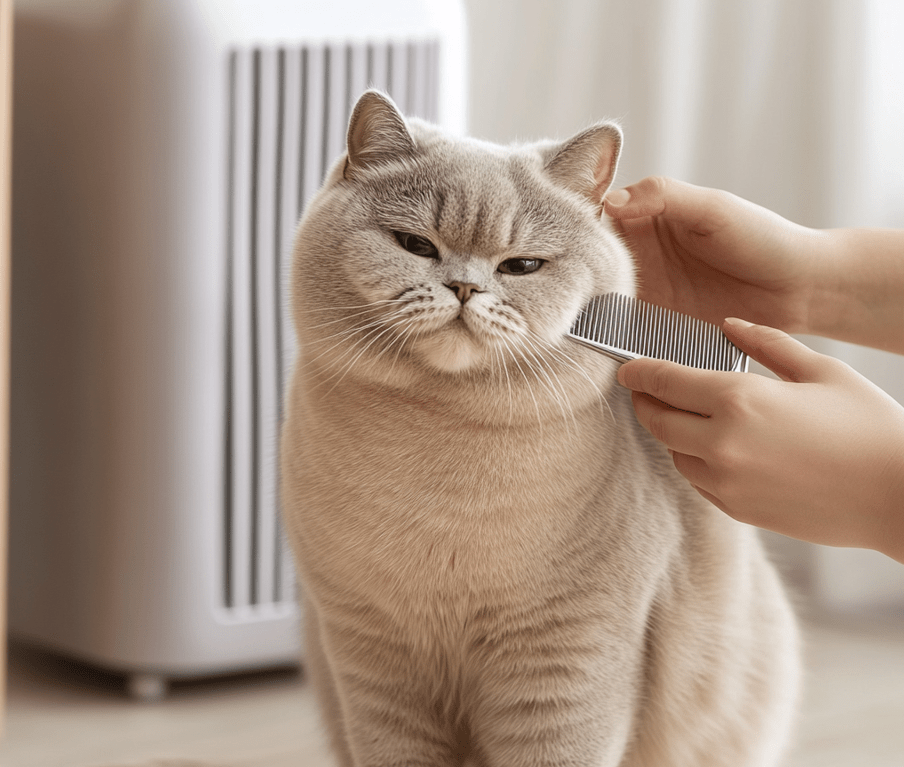
British Shorthair cats, with their dense, plush coats and charming, teddy-bear-like faces, are adored for their calm and affectionate nature. However, like all cats, British Shorthairs can suffer from allergies that affect their skin, respiratory system, or digestion. Recognizing and managing British Shorthair allergies is crucial for ensuring their comfort and well-being. This comprehensive guide explores common allergy triggers, their symptoms, and practical solutions to help your British Shorthair live a healthy, happy life. By understanding and addressing allergies, you can provide targeted care for your beloved feline companion.
Understanding Allergies in British Shorthairs
Allergies in cats occur when the immune system overreacts to a substance (allergen), triggering inflammation and discomfort. British Shorthairs may develop allergies to environmental factors, food, or parasites, leading to symptoms like itching, sneezing, or digestive issues. While their thick coats and sturdy builds (9-18 pounds) make them resilient, these traits can also trap allergens, increasing exposure. Early recognition and management of allergies can prevent chronic issues and improve your cat’s quality of life.
Types of Allergies in British Shorthairs
British Shorthairs are prone to three main types of allergies:
Environmental Allergies (Atopy): Reactions to airborne allergens like pollen, dust mites, or mold.
Food Allergies: Sensitivities to specific ingredients in their diet, such as proteins or additives.
Flea Allergy Dermatitis (FAD): An allergic reaction to flea saliva, causing intense itching.
Each type has distinct triggers and symptoms, requiring tailored approaches to management.
Common Allergy Triggers in British Shorthairs
Identifying the specific allergen causing your British Shorthair’s symptoms is the first step toward effective treatment. Below are the most common triggers for each allergy type.

Environmental Allergies
Pollen: Seasonal pollens from grasses, trees, or weeds can cause itching or respiratory issues, especially in spring or fall.
Dust Mites: These microscopic pests thrive in bedding, carpets, or furniture, triggering skin or respiratory reactions.
Mold Spores: Damp environments, like basements, can harbor mold, leading to allergies.
Household Chemicals: Cleaning products, air fresheners, or scented litter can irritate your cat’s skin or airways.
Human Dander or Perfumes: British Shorthairs may react to human skin cells or strong fragrances.
Food Allergies
Proteins: Common culprits include beef, chicken, fish, or dairy, which may trigger skin or digestive issues.
Grains: Some cats are sensitive to grains like wheat or corn, though true grain allergies are less common.
Additives: Artificial colors, flavors, or preservatives in commercial cat food can cause reactions.
Novel Ingredients: Even seemingly harmless ingredients, like certain vegetables, may be allergens.
Flea Allergy Dermatitis
Flea Saliva: A single flea bite can trigger intense itching in allergic cats, particularly around the base of the tail or neck.
Secondary Infections: Scratching can lead to bacterial or yeast infections, worsening symptoms.
Understanding these triggers helps you narrow down the cause of your British Shorthair’s allergies and take targeted action.
Symptoms of Allergies in British Shorthairs
Allergy symptoms vary depending on the type and severity of the reaction. Below, we categorize symptoms to help you recognize allergies in your British Shorthair.
Skin-Related Symptoms
Itching and Scratching: Persistent scratching, especially around the face, ears, or base of the tail, is a hallmark of allergies.
Red or Inflamed Skin: Redness, particularly on the belly, paws, or ears, may indicate an allergic reaction.
Hair Loss: Over-grooming or scratching can cause bald patches or thinning fur.
Sores or Scabs: Open sores, known as hot spots, may develop from intense scratching.
Miliary Dermatitis: Small, crusty bumps on the skin, often caused by flea allergies or atopy.
Respiratory Symptoms
Sneezing or Coughing: Frequent sneezing or wheezing may signal environmental allergies.
Runny Nose or Eyes: Watery discharge from the nose or eyes can occur with pollen or dust mite allergies.
Breathing Difficulties: In severe cases, allergies may cause labored breathing, requiring immediate veterinary attention.
Digestive Symptoms
Vomiting or Diarrhea: Food allergies often cause gastrointestinal upset, such as vomiting or loose stools.
Poor Appetite: Allergic cats may eat less due to nausea or discomfort.
Weight Loss: Chronic digestive issues can lead to unintended weight loss.
Behavioral Changes

Irritability: Discomfort from itching or pain may make your British Shorthair more aggressive or withdrawn.
Lethargy: Allergies can cause fatigue, reducing your cat’s usual playfulness.
Excessive Grooming: Over-grooming, especially licking the belly or paws, is a common stress response to allergies.
Monitoring these symptoms allows you to seek veterinary care promptly and prevent complications.
Diagnosing Allergies in British Shorthairs
Accurate diagnosis is essential for effective allergy management. Veterinarians use a combination of methods to identify the cause of your British Shorthair’s symptoms.
Physical Examination: Your vet will check for skin lesions, ear infections, or respiratory issues to assess allergy severity.
History Review: Providing details about your cat’s diet, environment, and symptom onset helps narrow down triggers.
Flea Checks: A thorough inspection confirms or rules out flea allergy dermatitis.
Food Elimination Trials: For suspected food allergies, your vet may recommend a 8-12 week trial with a novel or hydrolyzed protein diet to identify trigger ingredients.
Allergy Testing: Intradermal skin tests or blood tests can pinpoint environmental allergens, though they’re less common in cats than in dogs.
Skin Scrapings or Cultures: These rule out infections or parasites that mimic allergy symptoms.
Work closely with your veterinarian to develop a diagnostic plan tailored to your British Shorthair’s needs.
How to Help Your British Shorthair with Allergies
Managing British Shorthair allergies involves eliminating triggers, relieving symptoms, and supporting overall health. Below are practical, evidence-based strategies to help your cat.
1. Control Flea Allergy Dermatitis
Flea allergies are a leading cause of itching in British Shorthairs, so effective flea control is critical.
Use Vet-Approved Flea Preventatives: Products like Revolution, Frontline, or Bravecto provide long-lasting flea protection. Apply or administer as directed.
Treat the Environment: Vacuum carpets, wash bedding, and use pet-safe flea sprays to eliminate fleas in your home.
Check Regularly: Inspect your cat’s coat, especially around the tail base, for fleas or flea dirt (small black specks).
Treat All Pets: If you have multiple pets, ensure all are on flea preventatives to prevent reinfestation.
Consistent flea control prevents allergic reactions and secondary infections.
2. Manage Environmental Allergies
Reducing exposure to environmental allergens can significantly alleviate symptoms.
Keep Your Home Clean: Vacuum regularly, wash bedding weekly, and use HEPA air filters to reduce dust mites, pollen, and mold.
Limit Outdoor Exposure: Keep your British Shorthair indoors during high pollen seasons to minimize allergen contact.
Use Hypoallergenic Products: Choose unscented litter, pet-safe cleaners, and fragrance-free grooming products to avoid irritation.
Bathe Your Cat: Regular baths with a vet-recommended hypoallergenic shampoo, like Douxo S3 Calm, can remove allergens from the skin and coat. Bathe every 1-2 weeks, depending on your vet’s advice.
Control Humidity: Use a dehumidifier in damp areas to prevent mold growth.
These steps create a low-allergen environment, reducing your cat’s exposure to triggers.
3. Address Food Allergies
Food allergies require dietary changes to eliminate trigger ingredients.
Switch to a Novel Protein Diet: Foods with proteins like duck, rabbit, or venison (e.g., Royal Canin Selected Protein or Hill’s Prescription Diet z/d) can reduce reactions.
Try Hydrolyzed Diets: These diets break proteins into smaller molecules that are less likely to trigger allergies.
Avoid Table Scraps: Human foods can introduce allergens, so stick to your cat’s prescribed diet.
Monitor for Improvement: Food trials take 8-12 weeks to show results. Keep a symptom journal to track progress.
Consult your veterinarian to select the right diet and ensure nutritional balance.
4. Relieve Symptoms with Veterinary Treatments
Veterinary interventions can provide immediate relief and manage chronic symptoms.
Antihistamines: Drugs like chlorpheniramine may reduce itching or sneezing in mild cases, but they’re less effective in cats than in humans.
Corticosteroids: Prednisolone or dexamethasone can quickly reduce inflammation and itching, but long-term use requires monitoring due to side effects.
Immunotherapy: For severe environmental allergies, allergy shots or sublingual drops based on test results can desensitize your cat to specific allergens.
Antibiotics or Antifungals: Secondary skin infections from scratching may require topical or oral medications.
Omega-3 Supplements: Fish oil supplements, such as Nordic Naturals Omega-3 Pet, reduce inflammation and support skin health.
Follow your veterinarian’s guidance to ensure safe and effective treatment.
5. Support Skin and Coat Health
A healthy skin barrier can reduce allergy symptoms and prevent secondary issues.
Regular Grooming: Brush your British Shorthair’s dense coat 2-3 times weekly to remove allergens and distribute natural oils. Use a soft brush to avoid skin irritation.
Moisturizing Sprays: Vet-recommended sprays or mousses can soothe dry, itchy skin.
Ear Cleaning: Clean ears weekly with a vet-approved solution to prevent infections, which allergies can exacerbate.
Nail Trimming: Keep nails trimmed to minimize damage from scratching.
Consistent grooming supports your cat’s comfort and reduces allergen buildup.
6. Create a Stress-Free Environment
Stress can worsen allergy symptoms by increasing inflammation and grooming behaviors.
Provide Safe Spaces: Offer cozy beds or hideaways where your cat can relax undisturbed.
Use Pheromone Diffusers: Feliway diffusers release calming pheromones to reduce stress-related grooming.
Enrich Their Environment: Provide cat trees, window perches, and interactive toys to keep your cat mentally stimulated.
Maintain Routine: Consistent feeding, play, and litter box schedules create a sense of security.
A calm environment supports your British Shorthair’s overall health and reduces allergy flare-ups.
7. Schedule Regular Veterinary Checkups
Routine veterinary care is essential for monitoring allergies and preventing complications.
Annual or Biannual Exams: Regular checkups allow your vet to assess your cat’s skin, ears, and overall health.
Allergy Monitoring: Track symptom changes and treatment effectiveness during visits.
Blood or Skin Tests: These can rule out other conditions, like thyroid disease, that mimic allergy symptoms.
Dental Care: Oral health issues can contribute to stress and skin problems, so regular dental cleanings are crucial.
Open communication with your veterinarian ensures personalized allergy management for your British Shorthair.
Common Allergy-Related Conditions in British Shorthairs
Allergies can lead to secondary conditions that require specific attention.
Skin Infections
Bacterial or yeast infections from scratching can worsen itching and require antibiotics or antifungal treatments.
Ear Infections
Allergies often cause ear inflammation, leading to infections. Regular ear cleaning and veterinary checks prevent complications.
Asthma
Environmental allergies may trigger feline asthma, characterized by wheezing or coughing. Inhaled medications or environmental changes can manage symptoms.

Gastrointestinal Issues
Food allergies can cause chronic vomiting or diarrhea, requiring dietary adjustments and supportive care.
Addressing these conditions promptly prevents long-term health issues.
The Role of Observation in Allergy Management
Regular observation is key to managing British Shorthair allergies, as symptoms can be subtle.
Track Symptoms: Note changes in scratching, sneezing, or appetite using a journal or app.
Monitor Grooming: Excessive licking or chewing may indicate worsening allergies.
Check Skin and Coat: Look for redness, scabs, or hair loss during grooming sessions.
Consistent monitoring allows you to act quickly when symptoms flare, improving your cat’s comfort.
Choosing the Right Products for Allergy Management
Selecting high-quality products can enhance your allergy management efforts.
Flea Preventatives: Revolution or Bravecto offer reliable flea control.
Hypoallergenic Shampoos: Douxo S3 Calm or Virbac Epi-Soothe soothe itchy skin.
Cat Food: Royal Canin, Hill’s, or Purina Pro Plan offer novel protein or hydrolyzed diets.
Air Purifiers: HEPA filters from Levoit or Dyson reduce airborne allergens.
Litter: Unscented, dust-free options like World’s Best Cat Litter minimize irritation.
Read labels, check for veterinary endorsements, and consult your vet to ensure products meet your cat’s needs.
Common Mistakes to Avoid
When managing British Shorthair allergies, steer clear of these pitfalls:
Ignoring Early Signs: Dismissing mild itching or sneezing can lead to chronic issues.
Using Human Products: Human shampoos or medications can harm your cat’s skin or health.
Incomplete Flea Control: Treating only your cat, not the environment, allows fleas to persist.
Rushing Food Trials: Changing diets too quickly can obscure allergy triggers.
Proactive, informed care prevents these mistakes and promotes your cat’s well-being.
Advances in Feline Allergy Care
Recent advancements have improved allergy management for British Shorthairs:
Allergy Testing: More accurate intradermal and blood tests pinpoint environmental allergens.
Novel Diets: Advanced hydrolyzed and limited-ingredient diets simplify food allergy management.
Immunotherapy: Customized allergy shots or drops offer long-term relief for atopy.
Topical Treatments: New sprays and mousses provide targeted skin relief without systemic side effects.
These innovations empower owners to manage allergies effectively.
Conclusion

Managing British Shorthair allergies requires a proactive approach to identify triggers, relieve symptoms, and support overall health. By controlling fleas, reducing environmental allergens, adjusting diets, and seeking veterinary care, you can help your cat live comfortably. Regular grooming, stress management, and observation further enhance your efforts, preventing complications like infections or asthma.
With dedication and the right strategies, you can ensure your British Shorthair enjoys a happy, itch-free life. For personalized advice, consult your veterinarian to create a tailored allergy management plan for your beloved feline companion.



